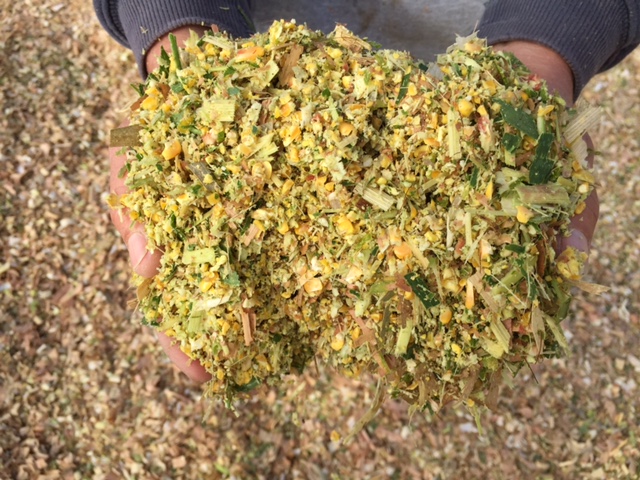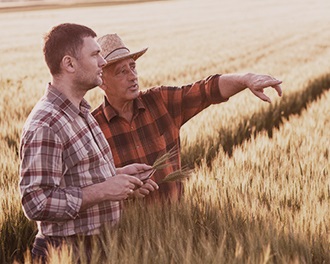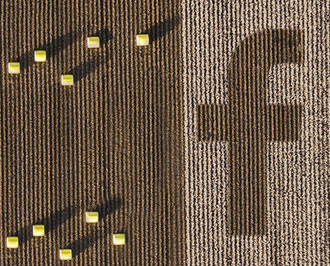Better animal nutrition — how silage and science can give you better results
2020
In conversation with Glenn Wild Ensuring livestock are in optimum condition is essential for producing quality food and fibre. And… Read more
In conversation with Glenn Wild
Ensuring livestock are in optimum condition is essential for producing quality food and fibre. And nutrition is one of the most important factors determining a livestock farmer’s success. When it comes to feeding animals, understanding the nutritional value of what your herd is eating will allow you to know whether it will help you achieve your goals profitably.
It’s a topic that Glenn Wild from Formula Forage — a fine chopped silage producer and total mixed ration manufacturer — is passionate about.
Here, he shares his knowledge on fodder and how farmers can achieve better results.
Before we get stuck in, could you tell us a bit about yourself
I was raised on my family’s dairy farm in the Mitta Valley, Victoria before moving to Canada when I was 24 to start my own silage harvesting business. For seven years, I spent six months in Canada in each year working their harvest. Canadians are real silage specialists because they have snow cover for six months of the year so ensiling fodder well is vital. As a result, I learned a lot about silage and saw an opportunity in Australia to improve how it’s done here.
So, I decided to move home and start my own high quality chopped silage and total mixed ration manufacturing business in 2013.
I now specialist in making baled chopped silage fodder products that give all farmers access to high-quality feed without the need to spend big bucks on the infrastructure necessary to make it themselves. I’ve got all the equipment, storage, and knowledge needed to produce 800kg bales that contain the desired proportions of fodder (almond hulls, cracked grain, corn silage, etc) and can transport them to farmers wherever they are.
All of this means that a smaller farmer’s animals can perform at the same level as a million-dollar feedlot operation.
How important is feed testing when it comes achieving better animal nutrition?
I believe it’s the foundation of good animal nutrition and I spend around $5000 each year testing all my feed. Testing allows farmers to see the exact nutritional value of the feed and its potential to improve livestock performance. This lets them see exactly what they’re paying for and allows them to weigh up the quality and prices of different fodder products easily.
It also allows me to understand the impacts of the weather and different production processes or decisions, and work out where there is room for improvement. For example, I can ask: what growth stage was the crop, what was the weather like, when did I cut back on nitrogen, and then compare the test data across different seasons to understand how to fine tune my production for higher quality feed.
The feed test is a transparent and objective way off assessing feed quality because the numbers don’t lie. I’m not interested in short term sales. Once a new client comes on board, I want to work with them and supply them for years to come — and feed testing is a tool that allows me to build this kind of trust.

In your experience, do all Australia farmers value feed testing?
It all depends on the farmer. Some of them really get the importance of feed testing and can interpret the feed report results themselves. Others see the benefits of feed tests but don’t know how to read the report so get an animal nutritionist to help them out. Others don’t see the need to feed test and will buy on price (because of choice or circumstance) or because of their existing fodder supplier relationships. My advice to all livestock farmers is to get a feed test and discuss it with an animal nutritionist because it will allow them to make smarter fodder decisions.
When you know the dry matter percentage (DM%), metabolisable energy (ME), and crude protein (CP) levels of your fodder you can calculate unit of cost of energy or protein, and hence determine the true dollar value of a stock feed. Knowing how to calculate the unit of cost numbers allow farmers to see whether a cheaper feed really is going to be good value in the long-term. In addition, the neutral detergent fiber (NDF), starch, and dietary cation-anion difference (DCAD) levels also need to be considered within the context of what farmers hope to achieve with their livestock by using a feed. This is something I can help farmers work out, or they can see how to do some of the sums themselves here: Buying feed at the right price
Why should farmers invest in premium feed?
Apart from the fact that a cheaper feed might cost more when you really break it down, premium feed can achieve better outcomes.
I’ve certainly seen positive results in the work I’ve done with dairy farmers. For example, at the start of 2017 I did some trial work with a client feeding my Formula Forage Lead Feed TMR to his pre-calving cows with a Dietary cation-anion difference (DCAD) of +50 and we saw dry matter intakes increase significantly. And there were no cases of milk fever.
Another client on a similar Lead Feed TMR increased dry matter intake by 10 dm/kg per day.
Another client changed his pre-calving technique from an ad lib scenario of hay and pellets, to a specific feed regime using my Lead Feed TMR, and went from an energy intake of 6 mj per dm/kg to 10.7 mj per dm/kg. The behaviour in his calving paddock changed, cows shinned, had the energy to push calves out without assistance and came into the dairy milking well.
What sets Formula Forage apart?
I am the only fodder supplier producing fine chopped forage in a bale. I also can mix minerals into a bulk forage source — something few others can do. Finally, I use science and data to make the best decisions, and have got world-class fodder experience that I can share with my farmers. All of this means that when a farmer comes to me we can work with their nutritionist to get tailor made feed products and the information they need to achieve their livestock performance goals.
Hay vs. silage — what wins when it comes to nutrition?
Funny you should ask because I think some people in Australia think of silage as the enemy because they don’t really understand it. They don’t get how to price silage based on its qualities in a comparable way to hay. They don’t really understand it’s nutritional make-up or the merit of feeding it. And that’s because producing good silage is a more involved process and requires specialist knowledge. Hay on the other hand is something our grandfathers have been making so most Aussie farmers and fodder associations feel more comfortable with it. Saying that, things have started to change here in the last several years and I think silage is rightly being held in higher regard. The contractor who does my chopped silage has seen a significant increase in the throughput of his harvester over the last five years. This is good news because I don’t think it makes sense for us to dismiss a fodder that’s been used effectively by some of the world’s best farmers.





